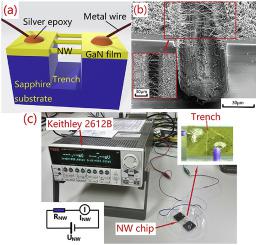当前位置:
X-MOL 学术
›
Curr. Appl. Phys.
›
论文详情
Our official English website, www.x-mol.net, welcomes your
feedback! (Note: you will need to create a separate account there.)
In situ control of nanowire resistance with real time monitoring by using self-heating induced oxidation
Current Applied Physics ( IF 2.4 ) Pub Date : 2020-07-01 , DOI: 10.1016/j.cap.2020.04.007 Yang Zong , Hui Huang , Danna Zhao , Zhenan Tang
Current Applied Physics ( IF 2.4 ) Pub Date : 2020-07-01 , DOI: 10.1016/j.cap.2020.04.007 Yang Zong , Hui Huang , Danna Zhao , Zhenan Tang

|
Abstract It was firstly demonstrated that the resistance of bridging GaN nanowires (NWs) can be in situ controlled via current driven self-heating. Owning to the absence of contact barrier at the electrodes of bridging NWs, the Joule-heating can be generated mainly on the NW itself rather than on the electrodes. With increase of NW bias-voltage (BiV) from 2.5 V to 10 V, the generated Joule-heating can make the NW oxidized in air, which leads to about 700 fold increase in NW resistance (from 82.5 Ω to 6 × 104 Ω). Theoretical simulation indicated that a NW temperature of 649 K can realized with a BiV of 4 V, which agrees well with the observation of thermal emission microscope. Moreover, the measured oxygen composition in the NWs was increased with increasing BiV, which indicates that the NWs were oxidized by BiV induced self-heating. This work provides a simple method for precise control of NW resistance, which can be further applied to the formation of core/shell NWs with real time monitoring.
中文翻译:

利用自热诱导氧化实时监测纳米线电阻的原位控制
摘要 首次证明桥接GaN纳米线(NWs)的电阻可以通过电流驱动的自加热进行原位控制。由于在桥接 NW 的电极处没有接触势垒,焦耳热可以主要在 NW 本身而不是电极上产生。随着 NW 偏置电压 (BiV) 从 2.5 V 增加到 10 V,产生的焦耳热可以使 NW 在空气中氧化,导致 NW 电阻增加约 700 倍(从 82.5 Ω 到 6 × 104 Ω) . 理论模拟表明,在 BiV 为 4 V 的情况下,可以实现 649 K 的 NW 温度,这与热发射显微镜的观察结果非常吻合。此外,NWs 中测得的氧组成随着 BiV 的增加而增加,这表明 NWs 被 BiV 诱导的自热氧化。
更新日期:2020-07-01
中文翻译:

利用自热诱导氧化实时监测纳米线电阻的原位控制
摘要 首次证明桥接GaN纳米线(NWs)的电阻可以通过电流驱动的自加热进行原位控制。由于在桥接 NW 的电极处没有接触势垒,焦耳热可以主要在 NW 本身而不是电极上产生。随着 NW 偏置电压 (BiV) 从 2.5 V 增加到 10 V,产生的焦耳热可以使 NW 在空气中氧化,导致 NW 电阻增加约 700 倍(从 82.5 Ω 到 6 × 104 Ω) . 理论模拟表明,在 BiV 为 4 V 的情况下,可以实现 649 K 的 NW 温度,这与热发射显微镜的观察结果非常吻合。此外,NWs 中测得的氧组成随着 BiV 的增加而增加,这表明 NWs 被 BiV 诱导的自热氧化。











































 京公网安备 11010802027423号
京公网安备 11010802027423号